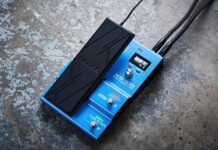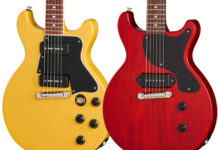
Strymon EC-1 review: “It does what it needs to do without any of the complexity of the big-box competition”
$279/£269, strymon.net
If you’re a pedal enthusiast, Strymon is a name you’ll know intimately well… hell even if you’re not, you probably recognise the company’s distinctive enclosures and may well have one or two on your ‘board.
READ MORE: TC Electronic Ditto 2 review: “The most easy to use looper on the market just got even better”
Because over the last decade or so the brand has become the standard bearer of quality time-based digital effects, if you want a brilliant sounding reverb or delay pedal, you can’t go wrong with a Strymon.
Increasingly, too, Strymon pedals have become a little more accessible. Starting with 2023’s Cloudburst, the brand has been experimenting with a smaller and more affordable form factor. Now, that tiny enclosure has seemingly come for the El Capistan – Strymon’s flagship tape echo pedal. Taking one of the onboard modes and squeezing it into the EC-1, is it a worthy Strymon purchase, or should you save up for the big boy?
Image: Press
Strymon EC-1 – what is it?
At first glance, it might be easy to think of the EC-1 as an El Capistan in a new slim enclosure. But I used the word ‘seemingly’ above quite deliberately, because this isn’t simply an El Cap algorithm in a smaller box. Strymon claims the EC-1 was in fact built new from the ground up (like the Cloudburst) to sound like a modded version of the iconic Echoplex EP-2 tape delay.
I’d also be very shocked if, like the Cloudburst with the BigSky MX, the EC-1 doesn’t end up as one of the new modes on the inevitable TimeLine MX whenever that arrives, but for now it’s unique to this pedal.
The EC-1 also offers a choice of two authentically reproduced preamp circuits that Strymon says will add a bit of vintage character to your input signal (though I’ll let your ears be the judge). One is based on a classic EP-2 tube preamp, ideal for brightening up your tone, while the other is based on a Cesar Diaz–modded EP-2 preamp circuit, adding a bit more warmth to your sound.
Another key difference from its bigger sibling is the addition of the Record Level control. The three-way Record Level toggle switch offers a clever means of tailoring the gain structure of the signal hitting the virtual record head.
In the low position, the circuit operates at unity gain with finely tuned biasing, delivering the cleanest, most transparent repeats your signal could ask for. Flip to medium, and you’re granted a tasteful 6dB boost — along with a nudge in bias — resulting in repeats that just begin to flirt with saturation.
For those seeking something a bit more unruly, the high setting unleashes a robust 12dB boost and a further bias escalation, producing echoes that are richly saturated, thick with harmonic colour, and brimming with vintage character.
With I/O including a premium JFET analog front end, a Class A JFET TRS stereo input, a low-impedance TRS stereo output, an expression pedal input, and a USB jack for MIDI control from a computer or firmware updates, at the heart of it all sits an ARM processor that’s as powerful – if not more powerful – than most smartphones, and even more powerful than many of its big-box counterparts.
Image: Press
Strymon EC-1 – sounds
To properly put the EC-1 through its paces, I paired it with my 1965 Fender Vibrolux Reverb and my tried-and-true Fender American Professional II Jazzmaster (equipped with the new Seymour Duncan Vintage Silencer Jazzmaster pickups).
Dialling the time to about 1 o’clock, the repeats to 9 o’clock, and the mix to about three-quarters of the way up yielded a result reminiscent of Joshua Tree-era The Edge. Tweaking the Mechanics and age controls added even more warble and character to the repeats – enough to make Ed O’Brien giddy.
For the chicken picking enthusiasts, you’ll be happy to know when dialled in just right the results will yield one of the cleanest and crystal-like slapback sounds I have had the joy of playing. Adding in a bit of warble will give it a bit of modulated motion that won’t be too overbearing in a mix.
But how does it work with other pedals? If I’m being transparent, I was genuinely worried about how the Tape Age and Mechanics settings would pair with other pedals – especially its sister the Cloudburst with the Ensemble switch engaged. I knew it was either going to be utterly amazing or a complete mess.
However, with Ensemble engaged, I was gobsmacked by the amount of lush ambience I was able to conjure from that combination. I found myself channelling riffs that would feel right at home between Parachutes-era Coldplay and Young Mountain-era This Will Destroy You. Needless to say, it put a smile on my face to hear how well this pairing accentuated the strengths of each pedal.
Image: Press
Strymon EC-1 – should I buy one?
Strymon’s fourth entry into their new smaller form factor is easily one of their most surprising releases to date. While taste is subjective, the EC-1 is one of the best echo pedals I’ve ever played. At a fraction of the cost, it does what it needs to do without any of the complexity of the big-box competition. If you’re looking for something that sounds better than El Capistan version 1 but comes with a smaller price tag than version 2, this is easily the pedal for you.
Strymon EC-1 – alternatives
Another pedal that offers a more streamlined take on the big box high-end delays is the Universal Audio Orion ($99/£95). Boss’s RE-2 ($241.99/£169) comes with authentic Space Echo sounds and looks in the iconic compact format, while the Catalinbread Belle Epoch ($209/£159) is hugely popular for a reason.
The post Strymon EC-1 review: “It does what it needs to do without any of the complexity of the big-box competition” appeared first on Guitar.com | All Things Guitar.
Source: www.guitar-bass.net












